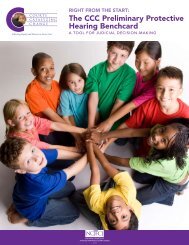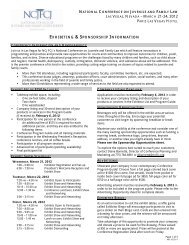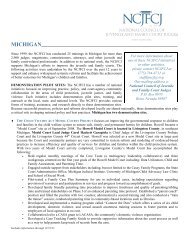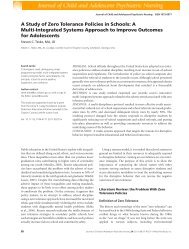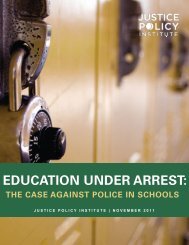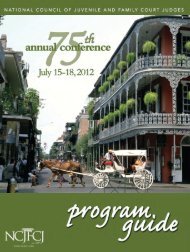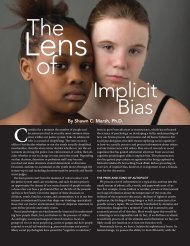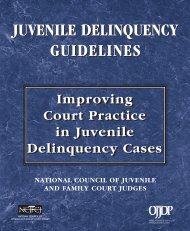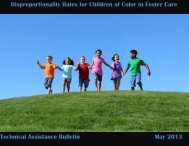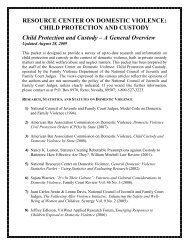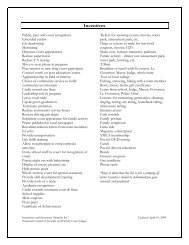Checklist
Checklist
Checklist
Create successful ePaper yourself
Turn your PDF publications into a flip-book with our unique Google optimized e-Paper software.
A JUDICIAL CHECKLIST<br />
for Children and Youth<br />
Exposed to Violence<br />
<strong>Checklist</strong><br />
“Children Reflect What They See”<br />
ARTWORK BY KATIE SCHULER FOR PINELLAS COUNTY, FLORIDA,<br />
SAFE START
CHECKLIST<br />
for Children and Youth Exposed to Violence<br />
Exposure to Violence & Type of Exposure<br />
Have risk factors for exposure to violence been identified?<br />
Risk factors include, but are not limited to:<br />
Chronic violence in the community from which the child was<br />
removed or currently resides (e.g. The following occur on a regular<br />
basis in the community: shootings, stabbings, homicides, muggings,<br />
drug deals, gang violence, etc.)<br />
Domestic (family) violence in the home from which the child was<br />
removed or currently resides (e.g. physical violence, threats, coercion<br />
or intimidation between parents, a parent and an unrelated paramour,<br />
a sibling towards a parent)<br />
Substance abuse and/or alcoholism by parent(s) or primary caregiver(s)<br />
Violence or ongoing bullying in the school that the child attends or<br />
has attended<br />
Physical or verbal abuse in a teenage ‘dating’ relationship<br />
Involvement in a gang or close ties to anyone in a gang<br />
Child/youth has spent time living on the streets as a runaway or<br />
homeless youth<br />
___________________________________________________________________<br />
Are there indicators that the child has been negatively impacted by<br />
exposure to violence?<br />
Indicators may include:<br />
Physical violence towards people or animals<br />
Withdrawn or lack of affect or emotions (depression)<br />
Overly excitable behavior<br />
Aggressive behavior<br />
Difficulties regulating behavior (e.g. poor impulse control)<br />
Anxiety or hyper-vigilance<br />
Substance abuse and/or alcoholism by child or youth<br />
Risk taking behaviors (e.g. sexual promiscuity, drug use)<br />
Suicide attempts or other self-destructive behavior (e.g. selfmutilation<br />
or cutting)<br />
Difficulty paying attention<br />
Problems in school (e.g. truancy, poor grades, detentions,<br />
suspensions, expulsions, bullying—victim or perpetrator, etc.)<br />
Difficulty with peers and appropriate social interactions<br />
(e.g. fighting, unable to make friends)<br />
Diagnosis of Post Traumatic Stress Disorder (PTSD)<br />
___________________________________________________________________
If known, what type of violence was the child/youth exposed to<br />
(e.g. community violence, domestic violence, teen dating violence,<br />
___________________________________________________________________<br />
school violence)?<br />
How was the child exposed to violence (e.g. heard the violent incident,<br />
saw the violent incident, was told about the violent incident,<br />
saw the aftermath of the violent incident - stitches, broken bones,<br />
___________________________________________________________________<br />
bruises in parents or family members)?<br />
Was the violence an isolated incident or were there multiple incidents?<br />
If multiple incidents, was the perpetrator the same each time or<br />
different?<br />
If multiple incidents, for how long has the child been exposed to<br />
___________________________________________________________________<br />
violent incidents?<br />
___________________________________________________________________<br />
Does the child/youth have a significant relationship with the perpetrator?<br />
Does the child/youth have a significant relationship with the direct<br />
___________________________________________________________________<br />
victim of the violent act or acts?<br />
Where did the violence take place?<br />
The child/youth’s home with biological family<br />
The child/youth’s placement (foster care, relative, non-relative)<br />
In the community/neighborhood<br />
At school<br />
At a friend’s house<br />
Other<br />
Legal System Responses<br />
If the juvenile court has jurisdiction over the perpetrator and/or<br />
the victim of the violence, has a court order been entered regarding<br />
contact between the perpetrator and the child/youth and/or the<br />
victim and the child/youth (e.g. supervised, unsupervised,<br />
therapeutic, no contact)?<br />
___________________________________________________________________<br />
If the juvenile court does not have jurisdiction over the perpetrator<br />
is a protective order necessary to protect the child/youth?<br />
If so, is a protective order in place or is one being sought in the<br />
appropriate venue?<br />
Who will assist or is assisting the child/youth and/or adult<br />
victim in seeking the restraining order?<br />
___________________________________________________________________<br />
Can the child’s/youth’s current caregiver protect him/her from<br />
further exposure to violence?<br />
Is the caregiver afraid of or threatened by the perpetrator (if known)?
Is the caregiver willing and able to enforce any restraining<br />
orders?<br />
Does the caregiver live in a neighborhood with a high likelihood of<br />
exposing the child/youth to acts of violence in the community? If so,<br />
see additional questions related to children’s exposure to violence?<br />
___________________________________________________________________<br />
Was/is law enforcement involved during or after the child’s/youth’s<br />
exposure to violence?<br />
If not, is it appropriate to contact law enforcement now?<br />
If so, were police reports generated and was the perpetrator<br />
arrested?<br />
___________________________________________________________________<br />
Is the perpetrator being prosecuted?<br />
If so, is the child/youth a witness and/or victim in the case?<br />
Does the child have a victim/witness advocate?<br />
Is a protective order necessary to minimize or prevent additional<br />
trauma?<br />
___________________________________________________________________<br />
Has the advocate for the child/youth inquired into the availability of<br />
crime victim compensation through state and/or federal entities?<br />
Therapeutic Interventions<br />
Has the child been referred for or undergone a psychological and/or<br />
developmental evaluation that specifically addresses whether the<br />
child was exposed to other forms of violence in addition to the issues<br />
that brought the family before the court?<br />
___________________________________________________________________<br />
Have recommendations been made by a licensed clinician regarding<br />
the necessary therapeutic interventions for the child/youth?<br />
Have the recommendations taken into consideration the age and<br />
developmental stage of the child/youth?<br />
Have these recommendations considered the cultural background<br />
and gender of the child?<br />
___________________________________________________________________<br />
Have referrals been made to the recommended therapeutic<br />
interventions?<br />
Do the interventions take into consideration the age and<br />
developmental stage of the child/youth?<br />
Are the interventions specifically tailored to the cultural<br />
background and gender of the child?<br />
If currently involved in treatment, are the child’s/youth’s current<br />
treatment and service providers aware of his or her exposure to the<br />
violence described above?<br />
Are these interventions age appropriate and developmentally<br />
appropriate?<br />
___________________________________________________________________
Additional Questions to Ask About Children and Youth<br />
Who Have Been Exposed to Domestic Violence<br />
Has the adult victim been provided an opportunity to seek an<br />
‘injunction for protection,’ ‘no contact order,’ or ‘protective order’?<br />
Is injunctive relief available within the juvenile or family court system?<br />
Does the injunction for protection include orders regarding the<br />
perpetrator’s contact with the children?<br />
Has the injunction been made a part of the court record?<br />
___________________________________________________________________<br />
Has the safety of the adult victim been considered when deciding<br />
matters regarding the well-being and protection of the children?<br />
Have visitation orders specifically addressed issues such as safe<br />
exchange and the confidentiality of the adult and child victims’ residence?<br />
___________________________________________________________________<br />
Are court hearings held in a manner that is safe for both the child<br />
and adult victims of domestic violence?<br />
Do the parents and child(ren) have separate attorneys and/or advocates?<br />
Is it possible to have separate hearings for the batterer and the victims?<br />
___________________________________________________________________<br />
Are child welfare professionals and domestic violence advocates<br />
coordinating their efforts to the extent it is feasible to do so?<br />
___________________________________________________________________<br />
Have both the child and adult victims been offered domestic violence<br />
related therapeutic and supportive services that are culturally<br />
sensitive?<br />
___________________________________________________________________<br />
Have the child and adult victims been linked with a community-based<br />
domestic violence advocate?<br />
Has the advocate provided information and education about<br />
domestic violence, the impact on children of exposure to domestic<br />
violence and safety planning?<br />
___________________________________________________________________<br />
Does this court have jurisdiction over the batterer?<br />
If so, has the batterer been required to attend a certified batterers’<br />
intervention program, or similar quality service, and has the<br />
batterer’s attendance and progress been closely tracked?<br />
If not, have the parties and the court worked with the criminal<br />
justice system and the victims to ensure that the batterer is held<br />
accountable for his/her actions (i.e. criminal prosecution of domestic<br />
violence, seeking a civil injunction for protection, prosecuting<br />
violations of probation or injunction)?<br />
___________________________________________________________________<br />
If an injunction is in place, has the batterer been in compliance?<br />
If not, has the adult victim contacted law enforcement regarding<br />
violations of the injunction?<br />
___________________________________________________________________
What community and/or domestic violence shelter-based programs<br />
are available to assist child and adult victims of domestic violence<br />
with basic needs (food, clothing, shelter) as well as supportive and<br />
therapeutic services, including domestic violence advocates?<br />
Has a working relationship been developed between these<br />
programs and the court?<br />
___________________________________________________________________<br />
Are there any community-based prevention and awareness educational<br />
efforts specifically aimed at educating families and professionals<br />
about the effects on children of exposure to domestic violence?<br />
Is the court coordinating with these educational campaigns to<br />
ensure that court-related professionals are informed about<br />
domestic violence and children?<br />
___________________________________________________________________<br />
Have formal relationships been developed between the court, child<br />
protective services and the domestic violence community to enhance<br />
cooperation, coordination and effectiveness?<br />
Additional Questions to Ask About Children and Youth<br />
Exposed to Community Violence<br />
Are community policing or similar efforts underway in the child’s<br />
current community or the community in which he or she will be<br />
placed?<br />
If so, have the victim’s advocates linked with community police to<br />
discuss the victim’s experience with community violence and<br />
possible safeguards that can be put in place?<br />
If not, has anyone connected with local law enforcement to<br />
institute a similar type of program?<br />
___________________________________________________________________<br />
Is the victim’s current placement in a ‘safe’ community or one that is<br />
known to be fraught with violence?<br />
If the victim is not in a ‘safe’ community or a ‘gun free school zone,’<br />
what efforts are being made to identify a safer living environment<br />
with either the same or different caregivers?<br />
___________________________________________________________________<br />
Has anyone helped the victim to identify a ‘safe haven’ in the<br />
community (i.e. school, community center, church, relative) that<br />
can provide a safe, supportive environment for the child?<br />
___________________________________________________________________<br />
Have therapeutic trauma-focused group interventions or services (i.e.<br />
school or community peer support groups or bereavement counseling)<br />
been offered to the victim?<br />
___________________________________________________________________
Is an appropriate caregiver or parent available to develop a<br />
“competent, caring, positive” relationship with the child to assist<br />
and support the child in coping with and overcoming trauma from<br />
community violence?<br />
___________________________________________________________________<br />
Is the victim able to identify a perpetrator of the community violence?<br />
If so, has law enforcement been contacted?<br />
If not, what efforts are being made to ensure that the perpetrator is<br />
brought to justice?<br />
___________________________________________________________________<br />
Are there any grassroots, community-based efforts being made to<br />
eradicate violence, especially gun violence, from the child’s<br />
community?<br />
If so, have legal system advocates connected with these organizations<br />
or leaders to identify ‘safe havens’ for children and youth living in<br />
violent communities?<br />
If not, how can the legal system work with community advocates<br />
and leaders to work to minimize the violence and its effect on<br />
children, youth and families?



